Junjie Huang
SciToolAgent: A Knowledge Graph-Driven Scientific Agent for Multi-Tool Integration
Jul 27, 2025Abstract:Scientific research increasingly relies on specialized computational tools, yet effectively utilizing these tools demands substantial domain expertise. While Large Language Models (LLMs) show promise in tool automation, they struggle to seamlessly integrate and orchestrate multiple tools for complex scientific workflows. Here, we present SciToolAgent, an LLM-powered agent that automates hundreds of scientific tools across biology, chemistry, and materials science. At its core, SciToolAgent leverages a scientific tool knowledge graph that enables intelligent tool selection and execution through graph-based retrieval-augmented generation. The agent also incorporates a comprehensive safety-checking module to ensure responsible and ethical tool usage. Extensive evaluations on a curated benchmark demonstrate that SciToolAgent significantly outperforms existing approaches. Case studies in protein engineering, chemical reactivity prediction, chemical synthesis, and metal-organic framework screening further demonstrate SciToolAgent's capability to automate complex scientific workflows, making advanced research tools accessible to both experts and non-experts.
Rethinking Lanes and Points in Complex Scenarios for Monocular 3D Lane Detection
Mar 08, 2025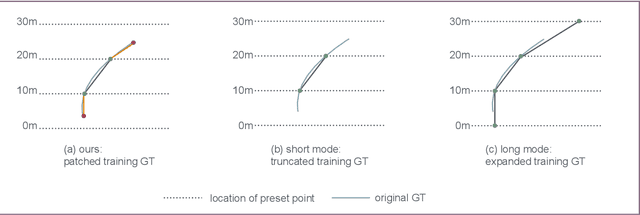
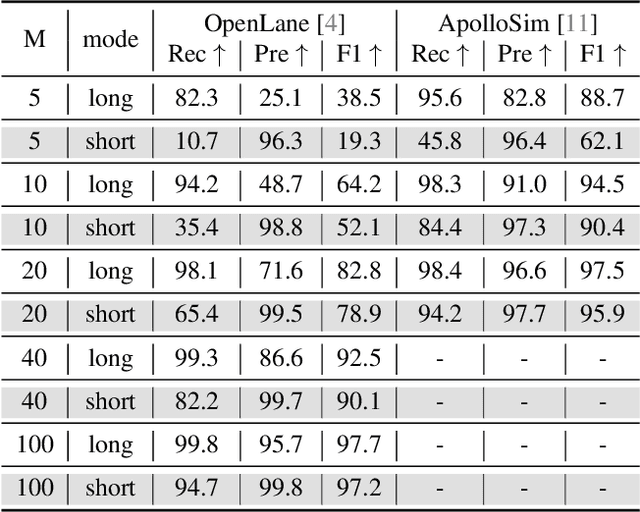
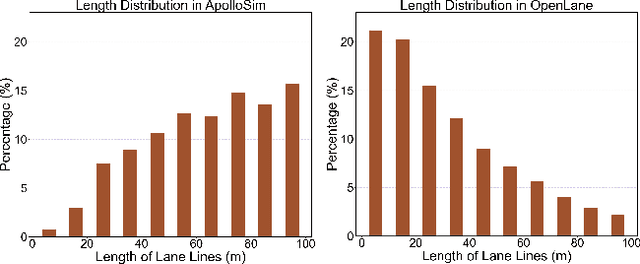

Abstract:Monocular 3D lane detection is a fundamental task in autonomous driving. Although sparse-point methods lower computational load and maintain high accuracy in complex lane geometries, current methods fail to fully leverage the geometric structure of lanes in both lane geometry representations and model design. In lane geometry representations, we present a theoretical analysis alongside experimental validation to verify that current sparse lane representation methods contain inherent flaws, resulting in potential errors of up to 20 m, which raise significant safety concerns for driving. To address this issue, we propose a novel patching strategy to completely represent the full lane structure. To enable existing models to match this strategy, we introduce the EndPoint head (EP-head), which adds a patching distance to endpoints. The EP-head enables the model to predict more complete lane representations even with fewer preset points, effectively addressing existing limitations and paving the way for models that are faster and require fewer parameters in the future. In model design, to enhance the model's perception of lane structures, we propose the PointLane attention (PL-attention), which incorporates prior geometric knowledge into the attention mechanism. Extensive experiments demonstrate the effectiveness of the proposed methods on various state-of-the-art models. For instance, in terms of the overall F1-score, our methods improve Persformer by 4.4 points, Anchor3DLane by 3.2 points, and LATR by 2.8 points. The code will be available soon.
Beyond Graph Convolution: Multimodal Recommendation with Topology-aware MLPs
Dec 16, 2024



Abstract:Given the large volume of side information from different modalities, multimodal recommender systems have become increasingly vital, as they exploit richer semantic information beyond user-item interactions. Recent works highlight that leveraging Graph Convolutional Networks (GCNs) to explicitly model multimodal item-item relations can significantly enhance recommendation performance. However, due to the inherent over-smoothing issue of GCNs, existing models benefit only from shallow GCNs with limited representation power. This drawback is especially pronounced when facing complex and high-dimensional patterns such as multimodal data, as it requires large-capacity models to accommodate complicated correlations. To this end, in this paper, we investigate bypassing GCNs when modeling multimodal item-item relationship. More specifically, we propose a Topology-aware Multi-Layer Perceptron (TMLP), which uses MLPs instead of GCNs to model the relationships between items. TMLP enhances MLPs with topological pruning to denoise item-item relations and intra (inter)-modality learning to integrate higher-order modality correlations. Extensive experiments on three real-world datasets verify TMLP's superiority over nine baselines. We also find that by discarding the internal message passing in GCNs, which is sensitive to node connections, TMLP achieves significant improvements in both training efficiency and robustness against existing models.
Revitalizing Reconstruction Models for Multi-class Anomaly Detection via Class-Aware Contrastive Learning
Dec 06, 2024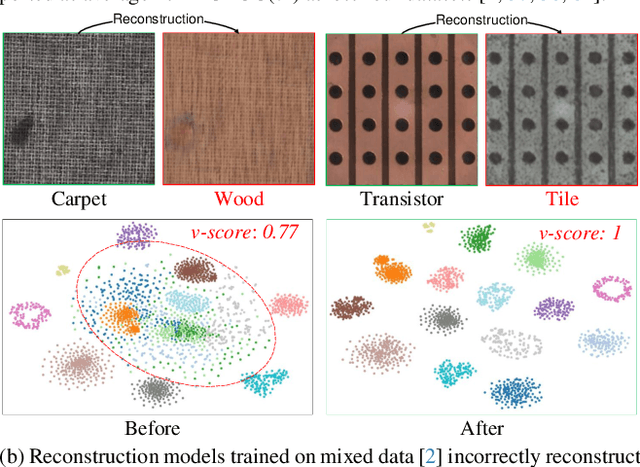

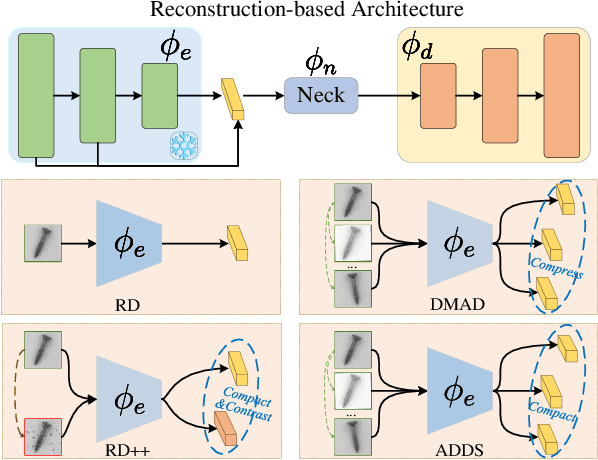

Abstract:For anomaly detection (AD), early approaches often train separate models for individual classes, yielding high performance but posing challenges in scalability and resource management. Recent efforts have shifted toward training a single model capable of handling multiple classes. However, directly extending early AD methods to multi-class settings often results in degraded performance. In this paper, we analyze this degradation observed in reconstruction-based methods, identifying two key issues: catastrophic forgetting and inter-class confusion. To this end, we propose a plug-and-play modification by incorporating class-aware contrastive learning (CL). By explicitly leveraging raw object category information (e.g., carpet or wood) as supervised signals, we apply local CL to fine-tune multiscale features and global CL to learn more compact feature representations of normal patterns, thereby effectively adapting the models to multi-class settings. Experiments across four datasets (over 60 categories) verify the effectiveness of our approach, yielding significant improvements and superior performance compared to advanced methods. Notably, ablation studies show that even using pseudo-class labels can achieve comparable performance.
Unleashing the Potential of Multi-Channel Fusion in Retrieval for Personalized Recommendations
Oct 21, 2024



Abstract:Recommender systems (RS) are pivotal in managing information overload in modern digital services. A key challenge in RS is efficiently processing vast item pools to deliver highly personalized recommendations under strict latency constraints. Multi-stage cascade ranking addresses this by employing computationally efficient retrieval methods to cover diverse user interests, followed by more precise ranking models to refine the results. In the retrieval stage, multi-channel retrieval is often used to generate distinct item subsets from different candidate generators, leveraging the complementary strengths of these methods to maximize coverage. However, forwarding all retrieved items overwhelms downstream rankers, necessitating truncation. Despite advancements in individual retrieval methods, multi-channel fusion, the process of efficiently merging multi-channel retrieval results, remains underexplored. We are the first to identify and systematically investigate multi-channel fusion in the retrieval stage. Current industry practices often rely on heuristic approaches and manual designs, which often lead to suboptimal performance. Moreover, traditional gradient-based methods like SGD are unsuitable for this task due to the non-differentiable nature of the selection process. In this paper, we explore advanced channel fusion strategies by assigning systematically optimized weights to each channel. We utilize black-box optimization techniques, including the Cross Entropy Method and Bayesian Optimization for global weight optimization, alongside policy gradient-based approaches for personalized merging. Our methods enhance both personalization and flexibility, achieving significant performance improvements across multiple datasets and yielding substantial gains in real-world deployments, offering a scalable solution for optimizing multi-channel fusion in retrieval.
ToCoAD: Two-Stage Contrastive Learning for Industrial Anomaly Detection
Jul 01, 2024



Abstract:Current unsupervised anomaly detection approaches perform well on public datasets but struggle with specific anomaly types due to the domain gap between pre-trained feature extractors and target-specific domains. To tackle this issue, this paper presents a two-stage training strategy, called \textbf{ToCoAD}. In the first stage, a discriminative network is trained by using synthetic anomalies in a self-supervised learning manner. This network is then utilized in the second stage to provide a negative feature guide, aiding in the training of the feature extractor through bootstrap contrastive learning. This approach enables the model to progressively learn the distribution of anomalies specific to industrial datasets, effectively enhancing its generalizability to various types of anomalies. Extensive experiments are conducted to demonstrate the effectiveness of our proposed two-stage training strategy, and our model produces competitive performance, achieving pixel-level AUROC scores of 98.21\%, 98.43\% and 97.70\% on MVTec AD, VisA and BTAD respectively.
Recall-Augmented Ranking: Enhancing Click-Through Rate Prediction Accuracy with Cross-Stage Data
Apr 15, 2024



Abstract:Click-through rate (CTR) prediction plays an indispensable role in online platforms. Numerous models have been proposed to capture users' shifting preferences by leveraging user behavior sequences. However, these historical sequences often suffer from severe homogeneity and scarcity compared to the extensive item pool. Relying solely on such sequences for user representations is inherently restrictive, as user interests extend beyond the scope of items they have previously engaged with. To address this challenge, we propose a data-driven approach to enrich user representations. We recognize user profiling and recall items as two ideal data sources within the cross-stage framework, encompassing the u2u (user-to-user) and i2i (item-to-item) aspects respectively. In this paper, we propose a novel architecture named Recall-Augmented Ranking (RAR). RAR consists of two key sub-modules, which synergistically gather information from a vast pool of look-alike users and recall items, resulting in enriched user representations. Notably, RAR is orthogonal to many existing CTR models, allowing for consistent performance improvements in a plug-and-play manner. Extensive experiments are conducted, which verify the efficacy and compatibility of RAR against the SOTA methods.
Knowledge-aware Alert Aggregation in Large-scale Cloud Systems: a Hybrid Approach
Mar 11, 2024Abstract:Due to the scale and complexity of cloud systems, a system failure would trigger an "alert storm", i.e., massive correlated alerts. Although these alerts can be traced back to a few root causes, the overwhelming number makes it infeasible for manual handling. Alert aggregation is thus critical to help engineers concentrate on the root cause and facilitate failure resolution. Existing methods typically utilize semantic similarity-based methods or statistical methods to aggregate alerts. However, semantic similarity-based methods overlook the causal rationale of alerts, while statistical methods can hardly handle infrequent alerts. To tackle these limitations, we introduce leveraging external knowledge, i.e., Standard Operation Procedure (SOP) of alerts as a supplement. We propose COLA, a novel hybrid approach based on correlation mining and LLM (Large Language Model) reasoning for online alert aggregation. The correlation mining module effectively captures the temporal and spatial relations between alerts, measuring their correlations in an efficient manner. Subsequently, only uncertain pairs with low confidence are forwarded to the LLM reasoning module for detailed analysis. This hybrid design harnesses both statistical evidence for frequent alerts and the reasoning capabilities of computationally intensive LLMs, ensuring the overall efficiency of COLA in handling large volumes of alerts in practical scenarios. We evaluate COLA on three datasets collected from the production environment of a large-scale cloud platform. The experimental results show COLA achieves F1-scores from 0.901 to 0.930, outperforming state-of-the-art methods and achieving comparable efficiency. We also share our experience in deploying COLA in our real-world cloud system, Cloud X.
FaultProfIT: Hierarchical Fault Profiling of Incident Tickets in Large-scale Cloud Systems
Feb 27, 2024Abstract:Postmortem analysis is essential in the management of incidents within cloud systems, which provides valuable insights to improve system's reliability and robustness. At CloudA, fault pattern profiling is performed during the postmortem phase, which involves the classification of incidents' faults into unique categories, referred to as fault pattern. By aggregating and analyzing these fault patterns, engineers can discern common faults, vulnerable components and emerging fault trends. However, this process is currently conducted by manual labeling, which has inherent drawbacks. On the one hand, the sheer volume of incidents means only the most severe ones are analyzed, causing a skewed overview of fault patterns. On the other hand, the complexity of the task demands extensive domain knowledge, which leads to errors and inconsistencies. To address these limitations, we propose an automated approach, named FaultProfIT, for Fault pattern Profiling of Incident Tickets. It leverages hierarchy-guided contrastive learning to train a hierarchy-aware incident encoder and predicts fault patterns with enhanced incident representations. We evaluate FaultProfIT using the production incidents from CloudA. The results demonstrate that FaultProfIT outperforms state-of-the-art methods. Our ablation study and analysis also verify the effectiveness of hierarchy-guided contrastive learning. Additionally, we have deployed FaultProfIT at CloudA for six months. To date, FaultProfIT has analyzed 10,000+ incidents from 30+ cloud services, successfully revealing several fault trends that have informed system improvements.
Detecting As Labeling: Rethinking LiDAR-camera Fusion in 3D Object Detection
Nov 13, 2023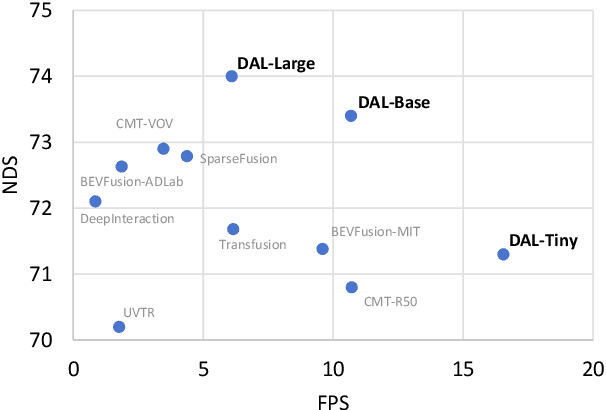

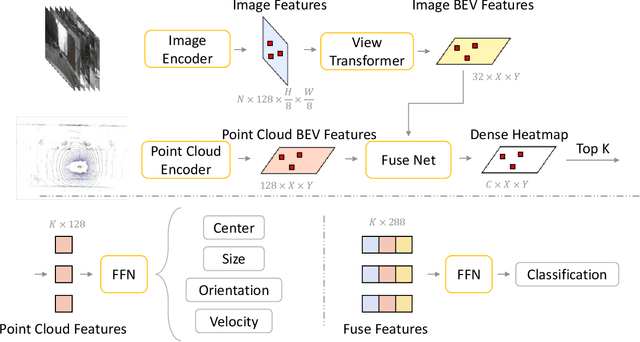
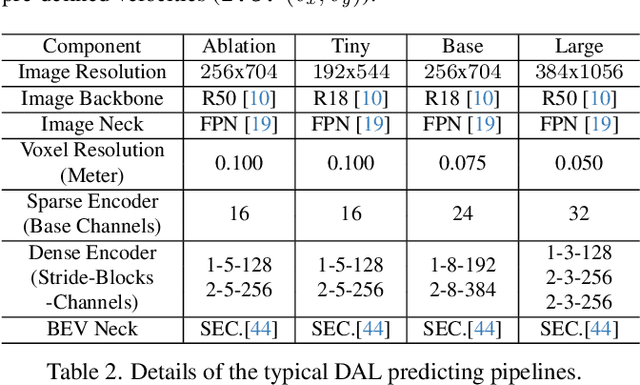
Abstract:3D object Detection with LiDAR-camera encounters overfitting in algorithm development which is derived from the violation of some fundamental rules. We refer to the data annotation in dataset construction for theory complementing and argue that the regression task prediction should not involve the feature from the camera branch. By following the cutting-edge perspective of 'Detecting As Labeling', we propose a novel paradigm dubbed DAL. With the most classical elementary algorithms, a simple predicting pipeline is constructed by imitating the data annotation process. Then we train it in the simplest way to minimize its dependency and strengthen its portability. Though simple in construction and training, the proposed DAL paradigm not only substantially pushes the performance boundary but also provides a superior trade-off between speed and accuracy among all existing methods. With comprehensive superiority, DAL is an ideal baseline for both future work development and practical deployment. The code has been released to facilitate future work on https://github.com/HuangJunJie2017/BEVDet.
 Add to Chrome
Add to Chrome Add to Firefox
Add to Firefox Add to Edge
Add to Edge